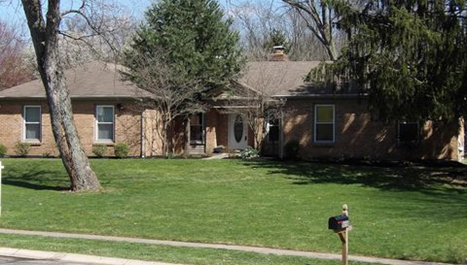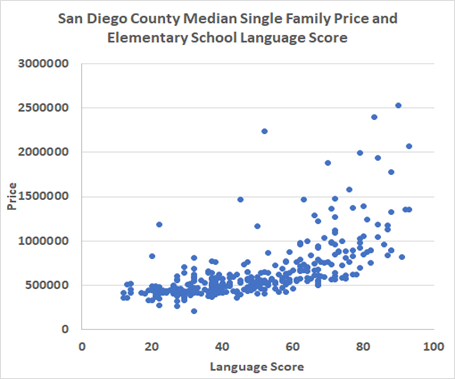by Dr. Michael Sklarz, Dr. Norman Miller and Dr. Anthony Pennington-Cross | April 17, 2018
Download a PDF file of this research paper here.
Introduction
At Collateral Analytics we always strive to improve our valuation models by incorporating new and better measures of factors that influence property value. Some of our recent research has been on waterfront properties and ongoing work continues to test for better ways to measure property condition. Here we focus on the impact of school quality. Many neighborhood attributes can affect the locational desirability of a home, including safety (crime), access to transportation networks, access to recreational opportunities (parks, cultural events, community swimming pools, and so on), the quality of the schools, and property taxes. The importance of any particular attribute depends on the purchaser’s preferences and, as a result, their willingness to pay for (or value) that attribute.
This research explores the impact of school quality on home values. Specifically, how much does school quality impact residential home price and how stable those premiums are over time. This research has enabled us to create a new set of home price series for elementary, middle, and high school areas throughout the U.S. as seen in the example in Exhibit 3 below. Economically, we would say that above average school quality as a flow of service is capitalized into value, just like an income stream. There is a broad consensus in the academic literature that school quality matters (Black, 1999, Brasington, 1999), and it seems that elementary school may matter even more than high school in driving locational preferences of home buyers with children. Empirical research has found that a one standard deviation increase in school quality (measured by test scores or school rankings) increases the value of a single family property by 1 to 3 percent. For a detailed review of the literature see Gibbons and Machin, 2008; Nguyen-Hoang and Yinger, 2011, and Ross and Yinger, 1999. However, recent research has indicated that there are some necessary conditions for good quality schools to be capitalized into value.
Much of the motivation for evaluating the capitalization of school quality, and the empirical challenges in identifying the effect, are derived from the Tiebout model (Tiebout, 1956). In the Tiebout framework, households will sort into neighborhoods that best match their preferences for local public goods. Households that value the bundle of attributes in a property the most will bid the highest value for the property. One of those attributes is the location. Applying this logic, households that value school quality the most will tend to cluster and live in locations with better school quality.
Researchers have focused on sales that are close to the border of a school attendance zone. The notion is that each side of an attendance border is still in the same neighborhood, even though the households send their children to different schools. This approach assumes that many of the unobservable attributes will be the same across the attendance boundary. There are good reasons to suspect this is not always true. Consider the attendance border between the city of Detroit and Grosse Pointe Park, Michigan, shown in Exhibit 1. The school attendance boundary is the alley between Alter Road and Wayburn Street. A visual inspection of the exhibit shows a real difference in the physical characteristics – homes on the Grosse Pointe Park side are packed more tightly, while the Detroit side of the boundary contains many empty homes and abandoned lots. Moreover, because the school boundary is also a municipal boundary, there will likely be substantial variations in municipal services between the two communities. Thus, sorting across the border along Alter Road is likely to be substantial, so that two homes on either side of the boundary with same square feet, beds and baths are not of the same quality or in the same neighborhood. An estimate along this border will mistakenly assign the impact of the neighborhood due to sorting to the higher ranked schools in Grosse Pointe Park (George Defer Elementary School Kindergarten through 5th grade Great Schools rating of 9, versus Carstens Elementary Middle Kindergarten through 8th grade Great Schools rating of 2 — accessed on 1/30/18, at www.greatschools.org). We believe we will be able to improve upon such research in the coming months with better neighborhood controls, and a better understanding of how real estate market conditions and cycles affect adjacent but different submarkets. One must be careful in doing such research, as we know public school quality is only one of many attributes that determine overall home value.[1]
Exhibit 1: City of Detroit Michigan and Grosse Pointe Park Michigan Boundary — Alley between Alter Road and Wayburn Street

Downloaded from Google maps satellite view in January 2018
Consider a better research subject area with a neighborhood where the homes are similar in size and age, but where the school district lines divide the neighborhoods. Such a case is Evendale/Princeton School District and Sycamore School District, both in the northern suburbs of Cincinnati, Ohio. We found two homes that were in the same area but assigned to two different schools. Both are one story, high ceiling homes. Both are 3 bedrooms, 2.5 baths. The value difference as of 2018 is 58% higher per square foot and $150,000 overall. Such homes in the less valued school district tend to be occupied by families without children or those sending their kids to parochial schools. The homes in the Sycamore school district are occupied primarily by younger families with more kids. This is what one would expect in an open market that sorts by location preferences.
Exhibit 2: Two similar homes in the same area affected mostly by school quality

3789 Monets Lane, 45241 Value Estimate $290,000 or $137.39 Per Sq Ft
2011 Square Feet Built in 1987 and bought in 2010 for $300,000

9662 Sycamore Trace Court, 45242 Value Estimate $440,000 or $217.50 Per Sq Ft
2023 Square feet Built in 1979 and bought in 2012 for $269,000
In Exhibit 3 below we show the median home prices in four school districts noting that price spreads are often persistent. The Evendale school districts overlap and have similar price trends. The High Schools include larger areas with one high school, Sycamore, existing in parts of two zip codes. Despite increasing focus on school quality in recent years, we have seen the fixed spreads in home values being quite consistent over time in most markets. The reason we see more volatility in the Sycamore 45241 area is simply because of the thinner sample in this market.
Exhibit 3: Persistence of School Price Spreads is Common

Exhibit 4 below shows median home prices by elementary school area for Mission Viejo, California ZIP Code 92692. Note that despite the significant volatility of overall home prices since 2000, the relative positions and spreads in home values have been quite consistent.
Exhibit 4: Persistence of School Price Spreads is Same ZIP Code
Exhibits 5, 6 and 7 illustrate the relationship between school performance tests and home values in San Diego County, using a scatter plot approach. We understand that there may be flaws in using such scores to reflect school quality as there is a bias based on the home environments which may differ, nevertheless, we do observe clear correlations. We see that within the county higher Elementary school math and language scores are correlated with more expensive housing. There is substantial variation, but the upward price trend is strong for both math and language scores. Exhibit 6 shows a similar relationship for high school level math scores within the county.
While this relationship is robust, high math scores alone do not explain house prices. For example, property quality and other location attributes such as waterfront views and access all can have large impacts on house value. In the academic literature, there is a growing recognition that, while there is a consensus of a 1 to 3 percent capitalization rate (for a one standard deviation increase in school quality), there are circumstances that could drive the capitalization rate up more or down to even zero.
Capitalization occurs because good quality schools attract households to the area and they bid up the value of the property. The bidding up of property value will occur in areas where high quality schools are in short supply. This lack of supply can occur indirectly through the ability to build more housing or build more high-quality schools (Hilber and Mayer 2009). In summary, locations with very few quality schools and a very rigid supply of housing should have the largest school quality capitalization rate. In contrast, places where development can occur fairly easily and where there are a lot of good quality schools should have lower school capitalization rates.
Exhibit 5: San Diego County Math Score and House Prices
Exhibit 6: San Deigo County Language Score and House Prices

Exhibit 7: San Diego County High School Math Scores and House Prices
Comments and Conclusions
At Collateral Analytics we have now collected the boundary data for all levels of schools from elementary through high school, along with test scores. We are in the process of working on the refinement of the impact of schools on home prices for the entire US. As this work progresses we will provide a more detailed research paper. For now, schools clearly matter to most but not all housing markets and we plan on sorting out those where it matters.
References
Black, Sandra E. 1999, “Do Better Schools Matter? Parental Valuation of Elementary Education” The Quarterly Journal of Economics, 114 (2), 577–599.
Brasington David M. 1999. “Which measures of school quality does the housing market value?” Journal of Real Estate Research, 18:3, 395–413.
Gibbons, Stephen and Stephen Machin. 2008. “Valuing school quality, better transport, and lower crime: Evidence from house prices.” Oxford Review of the Economy, 24(1), 99-119.
Hilber, Christian and Christopher Mayer. 2009. “Why do households without children support local public schools? Linking house price capitalization to school spending.” Journal of Urban Economics, 65, 74-90.
Hguyen-Hoang, Phuong and John Yinger. 2011. “The capitalization of school quality into house values: A review.” Journal of Housing Economics, 20, 30-48.
Ross, Stephen and John Yinger. 1999. “Sorting and voting: A review of the literature on urban public finance.: In Chesire, Paul., Mills, Edwin (Eds), Handbook of Urban and Regional Economics, vol. 3. North Holland, 2001-2060.
Tiebout, Charles. 1956. “A pure theory of local expenditures.” Journal of Political Economy, 64, 416-424.
_________________________________________________________
[1] For example, an outstanding parochial school may attract a certain segment of the market and offset an otherwise mediocre local public school.


